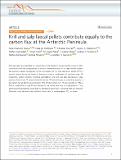Files in this item
Krill and salp faecal pellets contribute equally to the carbon flux at the Antarctic Peninsula
Item metadata
| dc.contributor.author | Pauli, Nora-Charlotte | |
| dc.contributor.author | Flintrop, Clara M. | |
| dc.contributor.author | Konrad, Christian | |
| dc.contributor.author | Pakhomov, Evgeny A. | |
| dc.contributor.author | Swoboda, Steffen | |
| dc.contributor.author | Koch, Florian | |
| dc.contributor.author | Wang, Xin-Liang | |
| dc.contributor.author | Zhang, Ji-Chang | |
| dc.contributor.author | Brierley, Andrew S. | |
| dc.contributor.author | Bernasconi, Matteo | |
| dc.contributor.author | Meyer, Bettina | |
| dc.contributor.author | Iversen, Morten H. | |
| dc.date.accessioned | 2021-12-16T11:30:07Z | |
| dc.date.available | 2021-12-16T11:30:07Z | |
| dc.date.issued | 2021-12-09 | |
| dc.identifier | 277041074 | |
| dc.identifier | 670dd1b2-8aed-4fce-9f64-a242745a70f0 | |
| dc.identifier | 85120936756 | |
| dc.identifier | 000728562700029 | |
| dc.identifier.citation | Pauli , N-C , Flintrop , C M , Konrad , C , Pakhomov , E A , Swoboda , S , Koch , F , Wang , X-L , Zhang , J-C , Brierley , A S , Bernasconi , M , Meyer , B & Iversen , M H 2021 , ' Krill and salp faecal pellets contribute equally to the carbon flux at the Antarctic Peninsula ' , Nature Communications , vol. 12 , 7168 . https://doi.org/10.1038/s41467-021-27436-9 | en |
| dc.identifier.issn | 2041-1723 | |
| dc.identifier.other | Jisc: 7b6e0c60e19047f884dfbbd2bf2c57a9 | |
| dc.identifier.other | publisher-id: s41467-021-27436-9 | |
| dc.identifier.other | manuscript: 27436 | |
| dc.identifier.other | ORCID: /0000-0002-6438-6892/work/104618884 | |
| dc.identifier.uri | https://hdl.handle.net/10023/24524 | |
| dc.description | This study was part of the project “Population shift and ecosystem response – krill vs. salps” funded by the Lower Saxony Ministry of Science and Culture (MWK) lead by B.M. M.H.I., C.M.F., C.K. and S.S. were supported by the HGF Young Investigator Group SeaPump “Seasonal and regional food web interactions with the biological pump”, VH-NG-1000. CMF was additionally supported by the AWI Strategy Fund project EcoPump. MHI was additionally supported by the DFG Research Center of Excellence “The Ocean Floor – Earth’s Uncharted Interface”: EX-2077-390741603. | en |
| dc.description.abstract | Krill and salps are important for carbon flux in the Southern Ocean, but the extent of their contribution and the consequences of shifts in dominance from krill to salps remain unclear. We present a direct comparison of the contribution of krill and salp faecal pellets (FP) to vertical carbon flux at the Antarctic Peninsula using a combination of sediment traps, FP production, carbon content, microbial degradation, and krill and salp abundances. Salps produce 4-fold more FP carbon than krill, but the FP from both species contribute equally to the carbon flux at 300 m, accounting for 75% of total carbon. Krill FP are exported to 72% to 300 m, while 80% of salp FP are retained in the mixed layer due to fragmentation. Thus, declining krill abundances could lead to decreased carbon flux, indicating that the Antarctic Peninsula could become a less efficient carbon sink for anthropogenic CO2 in future. | |
| dc.format.extent | 12 | |
| dc.format.extent | 1243969 | |
| dc.language.iso | eng | |
| dc.relation.ispartof | Nature Communications | en |
| dc.subject | GE Environmental Sciences | en |
| dc.subject | GC Oceanography | en |
| dc.subject | NDAS | en |
| dc.subject.lcc | GE | en |
| dc.subject.lcc | GC | en |
| dc.title | Krill and salp faecal pellets contribute equally to the carbon flux at the Antarctic Peninsula | en |
| dc.type | Journal article | en |
| dc.contributor.institution | University of St Andrews. Pelagic Ecology Research Group | en |
| dc.contributor.institution | University of St Andrews. School of Biology | en |
| dc.contributor.institution | University of St Andrews. Scottish Oceans Institute | en |
| dc.contributor.institution | University of St Andrews. Centre for Research into Ecological & Environmental Modelling | en |
| dc.contributor.institution | University of St Andrews. Marine Alliance for Science & Technology Scotland | en |
| dc.identifier.doi | 10.1038/s41467-021-27436-9 | |
| dc.description.status | Peer reviewed | en |
This item appears in the following Collection(s)
Items in the St Andrews Research Repository are protected by copyright, with all rights reserved, unless otherwise indicated.

